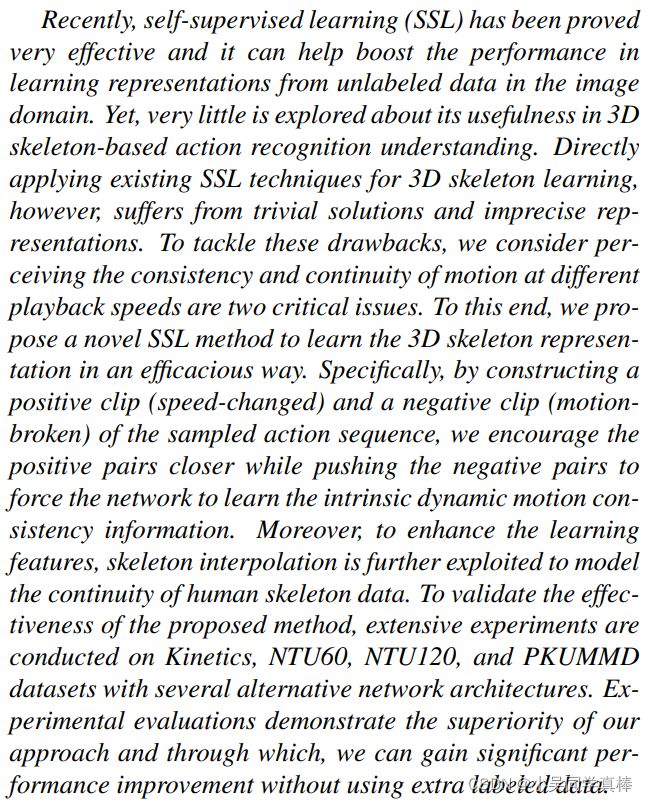【英文论文写作经验分享】1、Abstract 怎么写?
0、写在前面
犹豫了很久才开这个专栏。不想弄这个事情主要是觉得自己不是大佬,没有发过很多文章,没有资格教别人怎么写论文。但回想到自己写第一篇论文的无助之后,我想通了:正好我可以从一个小菜鸡的角度来分享一下学到的写作知识和小小的经验,也可以记录一下自己在英文写作过程中遇到的问题。欢迎各位大佬纠正。
博主是计算机视觉(Computer Vision,CV)领域的学生,所以我会以这个领域的论文为例分享一些东西。
在我个人看来,英文论文写作有几个要点(后面我想到了再继续补充):
- 英文论文写作是有很多套路的,它是挺八股文的一件事儿。
- 牢牢抓住论文写作的目的:让别人能读懂你的东西。所以不要一味的追求句子的漂亮和高级,让读者能读懂才是第一位,别捡了芝麻丢了西瓜。
- 逻辑很重要。连词!每句话为什么出现在这儿?和上下文有什么关系?
- 写之前列个大纲挺重要的,有助于展开思路。
今天先从写论文的套路开始吧!也是从论文里最重要的 Abstract 开始,它可是决定了读者会不会打开你的论文看的一大重要因素。
1、Abstract 的套路
既然是介绍写作的套路,那写出来的东西大概率就是中规中矩的,不会太出彩,但至少也不会出错,该有的东西都有。再要提升,就得靠实验结果好不好,方法的创新程度、平常的词句积累、论文阅读的积累等等。
简单来说,Abstract 就把这几件事写明白了:
- 背景(你研究的东西是什么 / 研究这个东西有什么意义?一般 1 句话说清楚就行)
- 现有方法的不足 / 该领域目前存在的问题(一般 1~2 句话说清楚就行)
- 我们怎么做的(方法的一个小概述,一般 2~4 句话说清楚就行)
- 方法的优势(一般就是解决了现有方法的不足 / 该领域目前存在的问题,一般 1~2 句话说清楚就行)
- 效果怎么样(一般 1~2 句话说清楚就行)
顺序以及比重可以略微调整,甚至可以省掉一些部分。
2、举个例子
以(ICCV 2021)的 Self-supervised 3D Skeleton Action Representation Learning with Motion Consistency and Continuity 为例:
https://openaccess.thecvf.com/content/ICCV2021/papers/Su_Self-Supervised_3D_Skeleton_Action_Representation_Learning_With_Motion_Consistency_and_ICCV_2021_paper.pdf![]() https://openaccess.thecvf.com/content/ICCV2021/papers/Su_Self-Supervised_3D_Skeleton_Action_Representation_Learning_With_Motion_Consistency_and_ICCV_2021_paper.pdf
https://openaccess.thecvf.com/content/ICCV2021/papers/Su_Self-Supervised_3D_Skeleton_Action_Representation_Learning_With_Motion_Consistency_and_ICCV_2021_paper.pdf
(1)背景
第 1~2 句话就是背景。
Recently, self-supervised learning (SSL) has been proved very effective and it can help boost the performance in learning representations from unlabeled data in the image domain. Yet, very little is explored about its usefulness in 3D skeleton-based action recognition understanding
大意是:自监督很有效果。在图像领域的任务里,已经有很多的方法通过使用自监督预训练,取得了性能上的极大提升。然而,没什么人在三维骨架点动作识别这个任务上做自监督与训练。
这句话就说明作者为什么要做这件事,有什么意义:作者为什么要做自监督?
(2)现有方法的不足 / 该领域目前存在的问题
第 3 句话就是现有方法的不足。
Directly applying existing SSL techniques for 3D skeleton learning, however, suffers from trivial solutions and imprecise representations.
大意是:直接把图像领域的自监督方法直接拿来用在三维骨架点上会让模型学到一些无关紧要的特征或者是不准确的特征表示。
这句话指出不足:现有的自监督方法不能直接拿来用在骨架点数据上。
(3)我们怎么做的 & 方法的优势
这篇文章是把这两部分杂糅在一起写的,范围在第 4~6 句话。
To tackle these drawbacks, we consider perceiving the consistency and continuity of motion at different playback speeds are two critical issues.
To this end, we propose a novel SSL method to learn the 3D skeleton representation in an efficacious way.
Specifically, by constructing a positive clip (speed-changed) and a negative clip (motionbroken) of the sampled action sequence, we encourage the positive pairs closer while pushing the negative pairs to force the network to learn the intrinsic dynamic motion consistency information. Moreover, to enhance the learning features, skeleton interpolation is further exploited to model the continuity of human skeleton data.
大意是:为了解决提出的不足,他们针对骨架点数据的两个特性(consistency 和 continuity)设计了两个适合骨架点数据的自监督任务。Specifically 后面就是介绍两个自监督任务的方法。
这部分就是介绍他们的方法:先总写,说明他们干了什么(第 4~5 句话),再分写,具体怎么做(第 6~7 句话)。
这么做的好处和优势夹杂在“具体怎么做”里(force the network to learn the intrinsic dynamic motion consistency information 和 enhance the learning features)。
(4)效果
第 7~8 句话就是该方法的效果。
To validate the effectiveness of the proposed method, extensive experiments are conducted on Kinetics, NTU60, NTU120, and PKUMMD datasets with several alternative network architectures.
Experimental evaluations demonstrate the superiority of our approach and through which, we can gain significant performance improvement without using extra labeled data.
大意是:为了验证所提出的方法的有效性,他们在三个数据集上和不同网络结构上做了实验。实验结果证明他们的方法取得了性能上的提升。
这两句话就指出效果:1、如何验证方法的有效性(在哪些数据集上做的实验,用的哪些网络架构等等)2、效果怎么样(一般都是很好啦)
